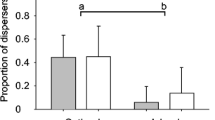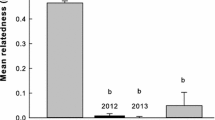Abstract
Xyleborini are a species-rich tribe of ambrosia beetles, which are haplodiploid and typically mate among siblings within their natal brood chamber. Several characteristics of this tribe would predict the evolution of higher levels of sociality: high genetic relatedness within galleries due to inbreeding, high costs of dispersal and the potential benefit of cooperation in brood care within the natal gallery (e.g. by fungus gardening, gallery extension, offspring feeding and cleaning). However, information on the social system of these beetles is very limited. We examined the potential for cooperative breeding in Xyleborinus saxeseni by monitoring dispersal in relation to brood size and composition. Results show that adult female offspring delay dispersal despite dispersal opportunities, and apparently some females never disperse. The females’ decision to stay seems to depend on the presence of eggs and dependent siblings. We found no indication that female offspring reproduce in their natal gallery, as colonies with many mature daughters do not contain more eggs than those with few or no daughters. There is a significant positive relationship between the number of females present and the number of dependent siblings (but not eggs), which suggests that cooperative brood care of female offspring raises colony productivity by improving survival rates of immatures. Our results suggest that cooperative breeding is likely to occur in X. saxeseni and possibly other xyleborine species. We argue that a closer look at sociality within this tribe may yield important information on the factors determining the evolution of cooperative breeding and advanced social organization.








Similar content being viewed by others
References
Aanen DK, Eggleton P, Rouland-Lefévre C, Guldberg-Frøslev T, Boomsma JJ, Rosendahl S (2002) The evolution of fungus-growing termites and their mutualistic fungal symbionts. Proc Natl Acad Sci USA 99:14887–14892
Alexander RD, Noonan KM, Crespi BJ (1991) The evolution of eusociality. In: Sherman PW, Jarvis JUM, Alexander RD (eds) The biology of the naked mole rat. Princeton University Press, Princeton, pp 1–44
Aoki S (1977) Colophina clematis (Homoptera, Pemphigidae), an aphid species with soldiers. Kontyu 45:276–282
Batra LR (1966) Ambrosia fungi: extent of specificity to ambrosia beetles. Science 153:193–195
Bignell D, Eggleton P (2000) Termites: evolution, sociality, symbioses, ecology. Kluwer, Dordrecht, The Netherlands
Bischoff LL (2004) The social structure of the haplodiploid bark beetle, Xylosandrus germanus. MSc Thesis, University of Berne, Switzerland
Chapman TW, Crespi BJ, Kranz BD, Schwarz MP (2000) High relatedness and inbreeding at the origin of eusociality in gall-inducing thrips. Proc Natl Acad Sci USA 97:1648–1650
Crespi BJ (1992) Eusociality in Australian gall thrips. Nature 359:724–726
Crespi B, Choe JC (1997) Introduction. In: Choe JC, Crespi B (eds) The evolution of social behavior in insects and arachnids. Cambridge University Press, Cambridge, pp 1–7
Crespi BJ, Mound LA (1997) Ecology and evolution of social behaviour among Australian gall thrips and their allies. In: Choe JC, Crespi BJ (eds) The evolution of social behavior in insects and arachnids. Cambridge University Press, Cambridge, pp 166–180
Duffy JE (1996) Eusociality in a coral-reef shrimp. Nature 381:512–514
Eichhoff W (1881) Die Europäischen Borkenkäfer. Julius Springer, Berlin
Emlen ST (1994) Benefits, constraints and the evolution of the family. Trends Ecol Evol 9:282–285
Farrell BD, Sequeira AS, O’Meara BC, Normark BB, Chung JH, Jordal BH (2001) The evolution of agriculture in beetles (Curculionidae: Scolytinae and Platypodinae). Evolution 55:2011–2027
Fischer M (1954) Untersuchungen über den kleinen Holzbohrer (Xyleborus saxeseni). Pflanzenschutzberichte 12:137–180
Gadagkar R (1990) Evolution of eusociality: the advantage of assured fitness returns. Phil Trans R Soc Lond B 329:17–25
Gagne JA, Kearby WH (1979) Life history, development and insect–host relationships of Xyleborus celsus (Coleoptera: Scolytidae) in Missouri. Can Entomol 111:295–304
Hadorn C (1933) Recherche sur la morphologie, les stades évolutifs et l’hivernage du bostryche liseré (Xyloterus lineatus Oliv.). Z Schweiz Forstvereins (Suppl) 11:1–20
Helms Cahan S, Sundström L, Liebig J, Griffin A (2002) Social trajectories and the evolution of social behaviour. Oikos 96:206–216
Hopkins AD (1898) On the history and habits of the “wood engraver” ambrosia beetle—Xyleborus xylographus (Say), Xyleborus saxeseni (Ratz.)—with brief description of different stages. Can Entomol 30:21–29
Hosking GB (1972) Xyleborus saxeseni, its life-history and flight behaviour in New Zealand. N Z J For Sci 3:37–53
Jordal BH, Normark BB, Farrell BD (2000) Evolutionary radiation of an inbreeding haplodiploid beetle lineage (Curculionidae, Scolytinae). Biol J Linn Soc 71:483–499
Kent DS, Simpson JA (1992) Eusociality in the beetle Austroplatypus incompertus (Coleoptera: Platypodidae). Naturwissenschaften 79:86–87
Kingsolver JG, Norris DM (1977) The interaction of Xyleborus ferrugineus (Fabr.) (Coleoptera: Scolytidae) behavior and initial reproduction in relation to its symbiotic fungi. Ann Entomol Soc Am 70:1–4
Kirkendall LR (1993) Ecology and evolution of biased sex ratios in bark and ambrosia beetles. In: Wrensch DL, Ebbert MA (eds) Evolution and diversity of sex ratio in insects and mites. Chapman & Hall, New York, pp 235–345
Kirkendall LR, Kent DS, Raffa KF (1997) Interactions among males, females and offspring in bark and ambrosia beetles: the significance of living in tunnels for the evolution of social behavior. In: Choe JC, Crespi BJ (eds) The evolution of social behavior in insects and arachnids. Cambridge University Press, Cambridge, pp 181–215
Koenig WD, Pitelka FA, Carmen WJ, Mumme RL (1992) The evolution of delayed dispersal in cooperative breeders. Q Rev Biol 67:111–150
Korb J, Lenz M (2004) Reproductive decision-making in the termite, Cryptotermes secundus (Kalotermitidae), under variable food conditions. Behav Ecol 15:390–395
McNee WR, Wood DL, Storer AJ (2000) Pre-emergence feeding in bark beetles (Coleoptera : Scolytidae). Environ Entomol 29:495–501
Merkl O, Tusnadi CsK (1992) First introduction of Xyleborus affinis (Coleoptera: Scolytidae), a pest of Dracaena fragrans ‘Massangeana’, to Hungary. Folia Entomol Hung 52:67–72
Mitteldorf J, Wilson DS (2000) Population viscosity and the evolution of altruism. J Theor Biol 204:481–496
Normark BB, Jordal BH, Farrell BD (1999) Origin of a haplodiploid beetle lineage. Proc R Soc Lond B 266:2253–2259
Peer K, Taborsky M (2004) Female ambrosia beetles adjust their offspring sex ratio according to outbreeding opportunities for their sons. J Evol Biol 17:257–264
Peer K, Taborsky M (2005) Outbreeding depression, but no inbreeding depression in haplodiploid ambrosia beetles with regular sibling mating. Evolution 59:317–323
Reeve HK, Westneat DF, Noon WA, Sherman PW, Aquadro CF (1990) DNA ‘fingerprinting’ reveals high levels of inbreeding in colonies of the eusocial naked mole rat. Proc Natl Acad Sci USA 87:2496–2500
Roeper R, Treeful LM, O’Brien KM, Foote RA, Bunce MA (1980) Life history of the ambrosia beetle Xyleborus affinis (Coleoptera: Scolytidae) from in vitro culture. Great Lakes Entomol 13:141–144
Roisin Y (1999) Philopatric reproduction, a prime mover in the evolution of eusociality? Insectes Soc 46:297–305
Saito Y (1997) Sociality and kin selection in Acari. In: Choe JC, Crespi BJ (eds) The evolution of social behavior in insects and arachnids. Cambridge University Press, Cambridge, pp 443–457
Saunders JL, Norris DM, Knoke JK (1967) Insect–host tissue interrelations between Xyleborus ferrugineus (Coleoptera: Scolytidae) and Theobroma cacao in Costa Rica. Ann Entomol Soc Am 60:419–423
Schneider I (1987) Verbreitung, Pilzübertragung und Brutsystem des Ambrosiakäfers Xyleborus affinis im Vergleich mit X. mascarensis (Coleoptera: Scolytidae). Entomol Gen 12:267–275
Schwenke W (1974) Die Forstschädlinge Europas. Paul Parey, Hamburg
Sherman PW, Lacey EA, Reeve HK, Keller L (1995) The eusociality continuum. Behav Ecol 6:102–108
Smith DR, Hagen RH (1996) Population structure and interdemic selection in the cooperative spider Anelosimus eximius. J Evol Biol 9:589–608
Taylor PD (1992a) Altruism in viscous populations—an inclusive fitness model. Evol Ecol 6:352–356
Taylor PD (1992b) Inclusive fitness in a homogeneous environment. Proc R Soc Lond B 249:299–302
Thorne BL (1997) Evolution of eusociality in termites. Ann Rev Ecolog Syst 28:27–54
Wade MJ (1980) An experimental study of kin selection. Evolution 34:844–855
West SA, Pen I, Griffin AS (2002) Conflict and cooperation - Cooperation and competition between relatives. Science 296:72-75
Wilson DS (2001) Cooperation and altruism. In: Fox CW, Roff DA, Fairbairn DJ (eds) Evolutionary ecology: concepts and case studies. Oxford University Press, Oxford, pp 222–231
Acknowledgment
We thank Ralph Bergmueller, Laurent Keller, Lawrence Kirkendall and anonymous referees for comments on previous drafts of the manuscript, and Dik Heg and Barbara Tschirren for statistical advice. The investigations comply with the current laws of Switzerland.
Author information
Authors and Affiliations
Corresponding author
Additional information
Communicated by D. Gwynne
Appendix
Appendix
Rights and permissions
About this article
Cite this article
Peer, K., Taborsky, M. Delayed dispersal as a potential route to cooperative breeding in ambrosia beetles. Behav Ecol Sociobiol 61, 729–739 (2007). https://doi.org/10.1007/s00265-006-0303-0
Received:
Revised:
Accepted:
Published:
Issue Date:
DOI: https://doi.org/10.1007/s00265-006-0303-0




